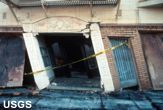Earthquakes Stopped, But Only In Lab

A new earthquake simulation experiment that shoved nubs of pressurized rock against one another resulted in a melting effect that stopped seismic slipping in its tracks.
The lab results with mirror-polished, thumb-sized surfaces of granite advance geophysicists' understanding of friction, but it's doubtful the same effect would hold with vast slabs of natural rock such as those found at the San Andreas Fault.
Earthquakes large and small supposedly start when energy builds in each side of a fault until it overcomes the seam's strength, causing sporadic rupturing fits and starts called stick-slips. Rock-crushing movement continues until the rock is stronger than the energy stored in the fault.
The new experiment was designed to see whether melting caused by friction of the slipping and sticking acts like a lubricant that enhances slipping or like a glue that restrains slipping.
The glue idea seems to stick.
"Melt materials are viscous, so most people may suppose that rock friction will be reduced once a melt layer is [inserted] between solid walls," said Kenshiro Otsuki of Tohoku University in Japan, who co-authored a paper on the experiment in a recent issue of the journal Geophysical Research Letters. "Our experimental results indicate that this supposition is not correct."
"Our experimental results elucidated that initial melts are very resistive to stop stick-slips," Otsuki told LiveScience.
Sign up for the Live Science daily newsletter now
Get the world’s most fascinating discoveries delivered straight to your inbox.
The halting effect of the melting process happened in a flash. In the experiment, melting started after just 12 microseconds, or millionths of a second, and got a grip strong enough to slow the slip dramatically at 18 microseconds.
The team used granite because it is common in the Earth's upper crust where earthquakes happen. To create the energy of a fault, the rock samples were subjected to more pressure than is measured at the bottom of the Pacific Ocean's Mariana Trench, the deepest known submarine trench on Earth. The resulting temperature was about 2,100 degrees Fahrenheit (1,150 Celsius).
But the lab result might have little to do with the real world because scientists are still learning about the mysterious ways of friction -- part of the basic fare in introductory physics classes -- in faults, says Tom Heaton, a geophysicist at Caltech.
"A lot of people have the view that people understand how earthquakes work. It builds up to a big stress and then it breaks. Over the last thirty years, people haven't been able to work out the details. It looks like something very exotic is happening," Heaton said in a telephone interview.
For starters, the melting that Otsuki's experiment predicts is not found in the field. Also, if the forces and effects in the experiment were scaled up to the size of the Earth, earthquakes would be much more violent than they already are, Heaton said.
"You'd be killed by a wall running into you at 50 mph," he said. Foot-thick slabs of rock could be melted.
Ironically, geophysicists now suspect earthquakes are gentler than we think and happen at relatively lower friction and lower stress in the rock than previously suspected.
So why do big earthquakes occur at all? Scientists are toying in the lab with new experiments to understand low-friction sliding. It could be that fast sliding causes flash melting that enables slipping. Or it could be that water in the rock introduces a cushion of steam that greases the wheels, Heaton said.
If these experiments start to translate to the natural world, "that might an incredible finding," Heaton said.
- Ominous Rumbling Under San Andreas Fault
- High Tides Trigger Earthquakes
- Scientists Test Materials With Fake Quakes
Robin Lloyd was a senior editor at Space.com and Live Science from 2007 to 2009. She holds a B.A. degree in sociology from Smith College and a Ph.D. and M.A. degree in sociology from the University of California at Santa Barbara. She is currently a freelance science writer based in New York City and a contributing editor at Scientific American, as well as an adjunct professor at New York University's Science, Health and Environmental Reporting Program.










